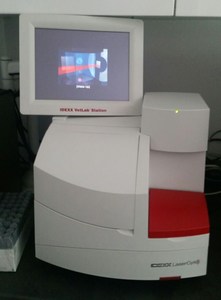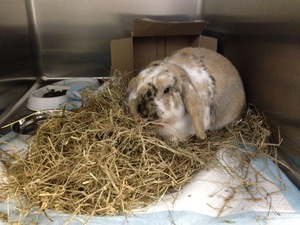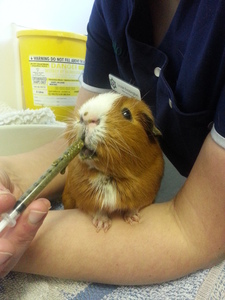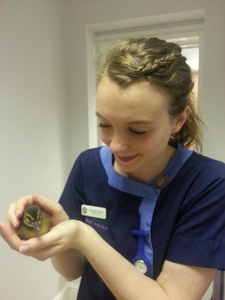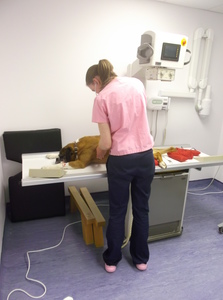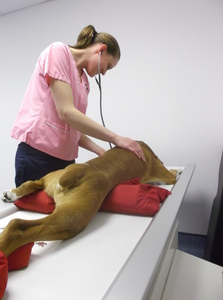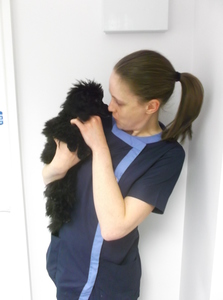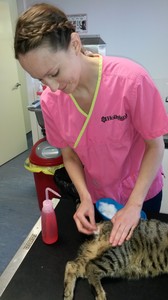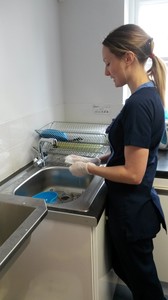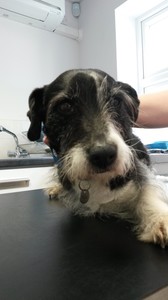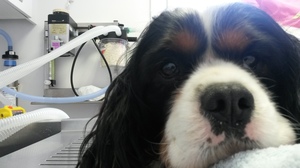For 2015’s Veterinary Nursing Awareness Month we will be spending a week in the shoes of each of our nurses. We are sure you will agree that their days and individual weeks are all very different and hope that you can appreciate how vital they are to the day to day running of Hollybank. Enjoy reading about their busy roles and hearing about some of their lovely patients!
Leonie’s blog
Monday
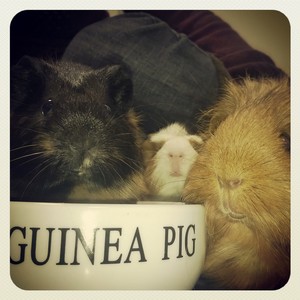 The weekend is over and it’s Monday again. My shift today began at 8am and I was greeted by Sami who had worked the weekend. As we had no inpatients there wasn’t much to handover. After I had checked everything was set up ready for the day ahead I got on with my first job of the day; caring for our three practice guinea pigs. They each needed weighing and their weights recorded on the computer. We weigh the girls once a week to ensure they are maintaining weight. Weight loss is a good indicator of pain or illness in small mammals so it is important to keep a regular record. The girls then needed fresh food and water for the day. As it was raining I kept them in their hutch instead of putting them in their outdoor run. When kept inside it is important to give them plenty of hay to munch on.
The weekend is over and it’s Monday again. My shift today began at 8am and I was greeted by Sami who had worked the weekend. As we had no inpatients there wasn’t much to handover. After I had checked everything was set up ready for the day ahead I got on with my first job of the day; caring for our three practice guinea pigs. They each needed weighing and their weights recorded on the computer. We weigh the girls once a week to ensure they are maintaining weight. Weight loss is a good indicator of pain or illness in small mammals so it is important to keep a regular record. The girls then needed fresh food and water for the day. As it was raining I kept them in their hutch instead of putting them in their outdoor run. When kept inside it is important to give them plenty of hay to munch on.
Once the girls were sorted I moved onto finishing our monthly jobs. This is a list of jobs we carry out once a month to keep the practice tidy and equipment maintained. One of the jobs I completed is checking sterile equipment. It is extremely important to maintain sterility within a veterinary practice to prevent unwanted infections. I had a look through all of the sterile equipment kept in theatre and placed those items to be sterilised again to one side. It was then time to start surgery.
Today we had a Golden Retriever in to remove a mass from under his neck, a Labrador for steroid injections into her elbows and a Cavalier King Charles Spaniel for a heart scan. First of all I assisted Charli with an extra patient that needed our care. Chica is a lovely 9 year old cross breed who came in as she was weak and wobbly. She had not eaten for a few days and seemed very painful on her hind legs. On exam, Chica had a temperature and her mucous membranes were pale. Initially Charli advised taking blood and urine samples, then to carry out an abdominal and thoracic ultrasound scan in order to rule out any internal bleeding. During the ultrasound scan we were checking for any obvious masses or free fluid that may have been the cause of Chica’s clinical signs, however, we did not find anything abnormal.
I then went up to the lab to run the samples of blood and urine to help rule in or out other possible causes. I used our blood machines to run a Biochemistry and haematology. The results showed minimal changes. I then used the urine to carry out a dipstick analysis and test the urines specific gravity (concentration) using a Refractometer. We had taken the urine via cystocentesis method; this is a sterile method using a needle and syringe to pierce the bladder wall and draw up urine. Once Charli had looked at the results we made a plan to make Chica comfortable; we placed her on intravenous fluids to help bring down her temperature and provided her with pain relief.
Once Chica was comfortable in her kennel I moved on to help Helen and Richard with Milly. Milly is stiff and sore in both of her elbows due to progression of arthritic changes. We first took x rays of Milly’s elbows. Milly was sedated during the procedure and my job was to monitor her under the sedation. It is important when monitoring a patient to keep a written record as this allows us to notice any sudden or slow changes to the patients breathing, heart rate, pulses, mucous membrane colour and capillary refill time. This allows the nurses and vets to quickly identify any changes and act to prevent any harm to the patient. Once the x-rays were finished it was my job to clip and prepare both of the elbows for steroid injections. The injections need to be given in a sterile manner as we are entering a sterile joint. Richard put on his sterile gloves and prepared the sterile needle and syringe. I clipped a square around each elbow and started cleaning the first elbow with an antimicrobial called Chlorrhexidine. Once I was satisfied the area was clean I placed on some surgical spirit and held the leg at a 45 degree angle ready for Richard to inject the steroid. I repeated this for the other elbow too. Once the procedure was finished I injected Milly with Atipamezole. This drug is given directly into the muscle and works relatively quickly to reverse the sedation. I placed Milly onto a comfy bed and sat with her while she woke up. Once Milly was awake I walked her back to kennels, let her settle on her bed and gave her a bowl of water.
2pm came around fast and it was time to check on Chica again. I started by monitoring and recording her temperature, pulse rate and respiration rate. It is important as nurses to monitor and record these parameters in order to point out any abnormalities or sudden changes to the vet in charge of the case. Chica’s parameters had not changed much however her heart rate had dropped slightly; it was 120bpm which is within the normal range for a dog. I then gave Chica a dose of Methadone which belongs to a group of drugs named opioids. These are strong pain relieving drugs and should help Chica feel a lot more relaxed and comfortable.
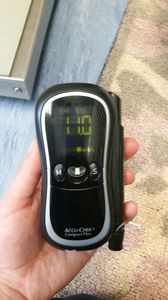 Chica is also diabetic so every four hours her blood glucose levels needed to be monitored. To do this I clipped a little patch of fur off one of her forelegs and wiped it with surgical spirit. I then used a tourniquet to raise the vein; it is important not to keep tourniquets on for too long as they can cause damage to the patient. Once I had found the vein I inserted the needle and drew back on the syringe to collect some blood. For a blood glucose measurement we only need a tiny amount of blood so I pulled the needle out once I had a drop in the syringe. I then placed the blood onto a little strip which comes out of a machine called a Glucometer. The Glucometer measures the blood glucose and provides a reading which we measure on a chart. Once this was done my last job with Chica is one I enjoy best, tempting inappetent patients to eat. As a nurse, this allows you to help the animal to eat and become better but also gives you an opportunity to sit and bond with your patient.
Chica is also diabetic so every four hours her blood glucose levels needed to be monitored. To do this I clipped a little patch of fur off one of her forelegs and wiped it with surgical spirit. I then used a tourniquet to raise the vein; it is important not to keep tourniquets on for too long as they can cause damage to the patient. Once I had found the vein I inserted the needle and drew back on the syringe to collect some blood. For a blood glucose measurement we only need a tiny amount of blood so I pulled the needle out once I had a drop in the syringe. I then placed the blood onto a little strip which comes out of a machine called a Glucometer. The Glucometer measures the blood glucose and provides a reading which we measure on a chart. Once this was done my last job with Chica is one I enjoy best, tempting inappetent patients to eat. As a nurse, this allows you to help the animal to eat and become better but also gives you an opportunity to sit and bond with your patient.
I then had time to do some general tidying of the practice. Today this involved; cleaning kennels after patients had gone home, washing food bowls, putting bedding in to be washed and putting away clean bedding. At 4pm I carried out another check on Chica. I recorded her temperature, pulse, respiratory rate and detached her from her fluids so I could take her outside to the toilet. As Chica was still sore on her hind limbs she was a little shaky and struggling to walk. I asked Katie to help me walk her outside; we used a towel as a sling underneath her tummy to help her up and to the garden area. Once outside she had a little potter around and there was no need for us to use the towel anymore as she became steady on her back legs. After Chica had been to the toilet I took her back to her kennel to let her settle again and attached her back onto her fluids. It was then 4:30pm; time for clinical rounds and then home to relax!
Tuesday
Its Tuesday and time for work. I start at 8am and I am greeted by Kat who is on the same shift as me today.Also in the practice is Cat who has just finished her night shift. Kat and Cat were finishing the checks on the in patients while I checked what consults I had this morning.
I gave them a hand while they checked Mac’s intravenous catheter, Mac was being a little wriggly so I rolled him over and gave him lots of tummy tickles while Kat stroked his head. During the distraction Cat unravelled his bandage and flushed his catheter. Once Mac was back in his kennel and all the in patients were content and comfortable I had a look on the computer system to see what the day ahead would bring.
My first consult of the day was an admit. Scamp is a little West Highland White Terrier who was coming in for a dental. After discussing the procedure and consent form with his owner I took Scamp through to kennels and got him settled in a bed. Next I admitted Daisy, a 5 year old ragdoll whose days of becoming a mother cat were over and she was in to be spayed. Daisy was a lovely little cat, I took her upstairs where she had a bed waiting for her in our cat ward.
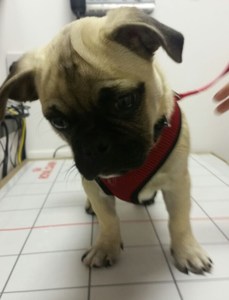 My next consult was a puppy club with Miller, a cheeky little 4 month old pug who just loves to lick everything! This was a chance to see how Miller and his mum were getting on with everything and if there were any concerns regarding socialising, training, insurance etc. I also wormed Miller today and after many attempts of tricking him by placing his tablets among treats and into his mouth he eventually ate them! We see puppies back once a month for a puppy club to provide advice to new and experienced owners and to answer any questions they may have regarding their new family member. During this time we also make sure they are up to date with worm and flea treatment, encourage microchipping, insurance and neutering. We try to ease any worries or concerns owners may have regarding their puppy. Puppy clubs also benefit the puppies, by coming into the practice for cuddles and treats by the nurse during puppy clubs they feel happier to come into the practice and more relaxed around the staff.
My next consult was a puppy club with Miller, a cheeky little 4 month old pug who just loves to lick everything! This was a chance to see how Miller and his mum were getting on with everything and if there were any concerns regarding socialising, training, insurance etc. I also wormed Miller today and after many attempts of tricking him by placing his tablets among treats and into his mouth he eventually ate them! We see puppies back once a month for a puppy club to provide advice to new and experienced owners and to answer any questions they may have regarding their new family member. During this time we also make sure they are up to date with worm and flea treatment, encourage microchipping, insurance and neutering. We try to ease any worries or concerns owners may have regarding their puppy. Puppy clubs also benefit the puppies, by coming into the practice for cuddles and treats by the nurse during puppy clubs they feel happier to come into the practice and more relaxed around the staff.
My next consult was a second Leptospirosis vaccine with a lovely greyhound named Leah. Leah is a 7 year old rescue dog and a delight to work with as she is very well mannered. Leah was not the slightest bit bothered by her injection so after a stroke and fuss she was on her way.
My morning consults were finished and it was then time to start Daisy’s surgery. I was in charge of monitoring Daisy’s anaesthetic. I collected her from her kennel and brought her to prep. After checking everything was set up properly and we had everything we needed to make the surgery run smoothly Helen injected the drugs to induce Daisy’s anaesthetic. We intubated Daisy and connected her to her oxygen and monitoring equipment. As all of our spay surgeries are done via a midline approach we placed Daisy onto a bean bag to keep her lay on her back during surgery. The surgical site was clipped and cleaned in prep so that theatre remained as sterile as possible. Once happy the site was clean I moved Daisy through to theatre. Once in theatre I ensured Daisy was in a position on the table that Helen was happy with and connected her back onto the circuit and monitoring equipment. Even though we have monitoring equipment it is still highly important to manually monitor and record patient’s parameters. Once Daisy was settled under the anaesthetic and I was happy that she was under the right plane of anaesthesia, not too light and not too deep, I was happy for Helen to start operating. Daisy’s surgery and anaesthetic ran smoothly and it was time to wake Daisy up. Once I was happy Daisy was awake enough I placed her into the incubator to keep warm and recover.
At 12 o’clock the inpatients needed medication. Chica was due doses of pain relief, anti-inflammatories and antibiotics. These could all be given intravenously. Whenever possible, we give drugs intravenously as they work quicker via this route and cause less stress for the patient. Chica was also due a blood glucose reading. She is very well behaved for all of her medications and blood samples. I then took her outside to the toilet, she seemed a little brighter outside today than she had previously which is always nice to see when you have been nursing a patient.
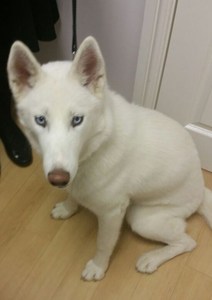 Next I had a 2 o’clock appointment with a Siberian husky named Echo. We had spayed Echo 5 days earlier. Echo was in to check her wound was healing nicely and she was bright and not painful. Echo walked through the door happy and wagging her tail, her wound was healing lovely. I graded this as a grade 1. We use a grading system for post op checks so they can be compared by other staff members and reviewed later on. Echo’s owner and I had no concerns with Echo so she was discharged today and can gradually return to her normal routine. Once all the surgery had finished and all the patients were back in their kennels I helped Katie with the cleaning. There is a lot of cleaning to do as a veterinary nurse and it is important to maintain high standards of cleaning to ensure the hospital is as clean as it possibly can be.
Next I had a 2 o’clock appointment with a Siberian husky named Echo. We had spayed Echo 5 days earlier. Echo was in to check her wound was healing nicely and she was bright and not painful. Echo walked through the door happy and wagging her tail, her wound was healing lovely. I graded this as a grade 1. We use a grading system for post op checks so they can be compared by other staff members and reviewed later on. Echo’s owner and I had no concerns with Echo so she was discharged today and can gradually return to her normal routine. Once all the surgery had finished and all the patients were back in their kennels I helped Katie with the cleaning. There is a lot of cleaning to do as a veterinary nurse and it is important to maintain high standards of cleaning to ensure the hospital is as clean as it possibly can be.
It was time for me to discharge Daisy, I explained all the post operative care to Daisy’s owner and provided her with a sheet of paper summarising what we spoke about. I had a feeling Daisy was excited to go home as she was meowing all the way to the consult room! Before rounds I had a little dog called Barnaby in to empty his anal glands; not the most glamorous of jobs but Barnaby was very well behaved. Barnaby has his anal glands emptied approximately once a month so he knows the score by now and makes it a quick and easy task for us.
It was then time for clinical rounds to discuss the cases of today and then home time.
Wednesday
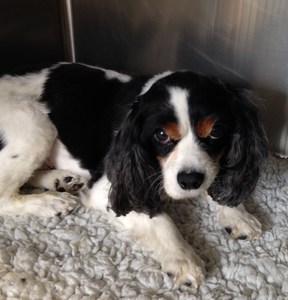 I arrived ready for work at 8am. After receiving the overnight handover and helping out with the inpatients I had a look to see what today would bring. Today we had an exploratory laparotomy on Noodle. Noodle is a little Cavalier King Charle’s Spaniel who had previously been in for a heart scan. Noodle had started vomiting not long after starting his heart medications and at first we thought this could have been the cause. After some symptomatic treatment initially Noodle did not improve. As a result we decided to investigate further and were very suspicious he had eaten something he shouldn’t of creating a foreign body in his tummy! Foreign bodies which are too big to be passed naturally need surgical removal to prevent them causing damage and blockages in the patient’s digestive system. While Katie and Charli prepped Noodle for surgery I started my morning consults.
I arrived ready for work at 8am. After receiving the overnight handover and helping out with the inpatients I had a look to see what today would bring. Today we had an exploratory laparotomy on Noodle. Noodle is a little Cavalier King Charle’s Spaniel who had previously been in for a heart scan. Noodle had started vomiting not long after starting his heart medications and at first we thought this could have been the cause. After some symptomatic treatment initially Noodle did not improve. As a result we decided to investigate further and were very suspicious he had eaten something he shouldn’t of creating a foreign body in his tummy! Foreign bodies which are too big to be passed naturally need surgical removal to prevent them causing damage and blockages in the patient’s digestive system. While Katie and Charli prepped Noodle for surgery I started my morning consults.
Wednesday morning I started with a 2nd Leptospirosis vaccine on a cute little dog. She was quite nervous of me and coming to the vets on the whole, so to prevent any further distress I popped her through to the back so she could have a cuddle with Katie while I injected her. She was very well behaved and was soon on her way out of the building. Next I saw a cat for a post dental check; he had a dental five days ago so he was brought in today to check his gums were healing nicely, he was eating and comfortable. Everything was fine and he seemed very bright and happy in the consult, he must feel much better now his teeth are nice and clean! I then had 2 more Leptospirosis vaccines, one on a gorgeous German shepherd dog and the other on a little Cavalier.
After this I had a weight club with two bouncy bulldogs. These two little guys have been coming in for a while trying to lose weight. Today they had both lost which was excellent news! They also have ongoing anal gland issues so we have decided to change their food to a diet with more fibre in which also promotes weight loss. We will see them back in 2 weeks to see how they are getting on. Weight clubs are very useful for pets that need to lose weight. Keeping your pet a healthy weight can not only minimise the risk of joint problems later on in life but also allows your pet to feel happier and fitter. Lots of owners notice a huge difference in their pet’s well-being once they are the ideal weight. It’s lovely as a nurse to take part in helping owners help their pets lose weight, we are here as support during this time and we too become happy and excited when the dog or cat has finally reached their target weight.
In between my consults I was answering the telephone to help out our receptionist. I had one call from a lady who wanted direction from Winsford. The trouble is I’m from Salford and don’t know the area that well myself! So I passed the call onto Penny who was happy to help.
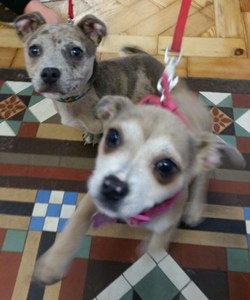 12 o’clock came around quickly and I was about to be greeted by two lovely little puppies for their first puppy club. It’s always good to have a little puppy therapy every now and then! Smokey and Poppy are two absolutely adorable cross breeds; Staffordshire bull terriers crossed with chihuahuas! They came in today for lots of fuss, treats, cuddles and not to forget their worm and flea treatment. I had a chat with their owners about how they were getting on with everything at home. They had been going to puppy training classes where Smokey was top of the class! Clever little man! I had booked them in for their next puppy club in 1 month and they left happy and full of beans.
12 o’clock came around quickly and I was about to be greeted by two lovely little puppies for their first puppy club. It’s always good to have a little puppy therapy every now and then! Smokey and Poppy are two absolutely adorable cross breeds; Staffordshire bull terriers crossed with chihuahuas! They came in today for lots of fuss, treats, cuddles and not to forget their worm and flea treatment. I had a chat with their owners about how they were getting on with everything at home. They had been going to puppy training classes where Smokey was top of the class! Clever little man! I had booked them in for their next puppy club in 1 month and they left happy and full of beans.
Once my consults had finished for the day I started writing out the consent forms for the next day. We write each patient on the white board in prep so everyone is aware of which patients we have in and what procedures they need. This also allows us to allocate one vet and one or two nurses to each patient with a time schedule. Doing this allows surgery and the practice to run smoothly as everyone is aware of what patient or job they are allocated to!
After this I carried out checks on the inpatients and walked them. I took part in our daily clinical rounds and then went home.
Thursday
I arrived ready for work at 8am. I was the only nurse in Thursday morning and the vets weren’t due in until 9 o’clock so I started doing some jobs around the practice. First of all I filled up consumables in the consulting rooms; It’s important to keep each room stocked up so we have everything we need. This means ensuring there are enough syringes, needles, intravenous catheters, sterile flush, blue roll, cotton wool and many other things we use on a daily basis. This also allows us to use these items quickly in case of any emergencies that may walk through the door. Once the vets were in it was time to open up and start the day.
Today I was mainly consulting. I enjoy consulting because its lovely to meet owners and interact with many pets in one day. It’s also a change working with healthy and happy pets as well as those that are ill. First of all I had two 2nd Lepstospirosis vaccines to give; one to a little Cocker Spaniel and one to a Border Collie with stiff legs. Kat runs mobility clinics here for pets who struggle with stiffness and arthritis; this little guy would be a good candidate.
Next I had an extremely friendly cat in to remove some staples we had placed in his leg. This well-mannered little man had a wound on his right hind leg which we had stapled 10 days previously. We usually leave staples in for 10 days to ensure the wound is healing over nicely and won’t reopen once the staples are out. It only takes a few seconds to remove staples and there’s no need for sedation. My last morning appointment was a post-operative check on a guinea pig that we had castrated. We see guinea pigs and rabbits back twice for post op checks. We see them 2 days and 5 days after surgery to ensure they are not losing weight and are eating properly. This was his second check; he had maintained weight, was eating perfectly well and was happy and bright in the consult. As a result, he was discharged today.
While I had some time in between consults I sent off a blood and urine sample to the external laboratory. I spun down one of the blood tubes using a machine called a centrifuge. The centrifuge rotates at high speeds to separate substances of different densities. After it was spun down I was left with blood cells in the bottom and serum at the top. I packaged the blood and urine in some cotton wool which will absorb the fluids if spilt and filled out the form for the lab.
Once this was complete and ready to be picked up by the courier I had a little dog to send home. Daisy was spayed today so I sent her home with post-operative instructions for her owner. It is important to keep a dog strictly rested after they have been spayed to prevent wound breakdown. I always recommend cage rest if possible but if not room rest with lead walks to the toilet only. It is also important to prevent jumping up furniture or climbing stairs and definitely no off lead exercise. Daisy had a little buster collar to go home with too which has to be kept on at all times to prevent her interfering with her wound. She also had some medication to go home with to help with the pain and inflammation. After making her a post op check appointment and ensuring her owner was happy with everything she was on her way home to sleep it off.
My last appointment of the day was a lovely Labrador who refused to go through to the consult room! After a few sneaky treats and lots of persuasion he finally came in, had his injection and was soon back out again!
Friday
It was the last day of the week and I started my shift at 8am. I assisted the vets scanning a little dog named Pearl. Pearl is a poodle who came in showing signs of pain. While scanning her we found out she had a very full tummy, there were signs of movement on the scanner so it was my job to take her outside and spend some time encouraging her to go to the toilet. Pearl is a nervous little dog so I walked her around the quiet part of the practice but she just wouldn’t go. We sent her home with some pain relief with hope that things would start moving along and she would pass faeces once she was in the comfort of her own home.
Today we had a 5 year old Persian cat in named Watson. Waston’s fur had become matted so he was being admitted today for a lion clip. A lion clip involves shaving the hair from most of his body but leaving a little around his neck, legs and tail. Nurses are not ones to win ‘groomer of the year’ but Watson will feel much better once his mats are out and will allow the fur to start growing again without mats.
We also had a rabbit in named Fudge. Fudge is a 4 year old mini lip who was with us today for a dental. I placed Fudge into a kennel. It is important that rabbits are given hay and food whilst they wait for their procedure as we want their guts to be constantly moving. We also provide a little box for them to hide in so they feel safe and secure while they are with us. Once he was settled I went down to the pharmacy to put up some medication. As nurses we cannot prescribe drugs but we can dispense. This helps the vets out if they are busy consulting as we can put up any medications they prescribe and dispense them to the client while they begin their next consult.
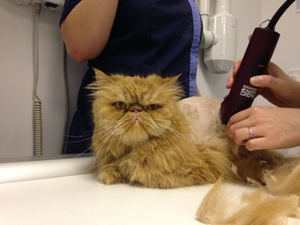 While we waited to start surgery, myself and Kat began to clip Watson’s fur. Watson was extremely well behaved and there was no need to sedate him. He didn’t seem to mind losing his fur as long as he was getting lots of fuss and ear rubs! Once Watson was halfway to his new hair cut we gave him a rest and started surgery. Later on Watson needed some sedation as his tummy was too tickly to clip conscious!
While we waited to start surgery, myself and Kat began to clip Watson’s fur. Watson was extremely well behaved and there was no need to sedate him. He didn’t seem to mind losing his fur as long as he was getting lots of fuss and ear rubs! Once Watson was halfway to his new hair cut we gave him a rest and started surgery. Later on Watson needed some sedation as his tummy was too tickly to clip conscious!
First of all Kat monitored a guinea pigs anaesthetic while I helped prep the surgical site, open surgical kits and moved the anaesthetic circuit through. As there is a higher anaesthetic risk with guinea pigs and rabbits it always helps to have two pairs of hands to minimise that risk. Once the guinea pig was recovering in the incubator it was time to start Fudges dental.
Fudge has had continuous problems in the past with his incisors. These are the four large teeth at the front of a rabbit’s mouth which constantly grow. We decided to remove Fudges incisors today to try and prevent the problems reoccurring. It was my job to monitor Fudge. I used a stethoscope so I could constantly hear his heart beat and note any changes in its rhythm whilst also monitoring his breathing. Once the incisors were out Richard burred little spurs on his other teeth and we quickly woke Fudge up. Once he was awake enough to come off oxygen I placed him in the incubator to recover.
It was now time to clean theatre. Once theatre, dental and prep were clean I got on with some of the Friday jobs before heading to rounds. The Friday jobs are a list of jobs we complete once a week to ensure all equipment in the practice is maintained. I started by checking all the endotracheal tubes. These are the tubes we use to intubate patients for general anaesthesia. I checked there were no tears in them and that the cuffs were fully inflatable with no holes in. I finished by cleaning the anaesthetic circuits before heading to rounds. After rounds it was time to go home and start the weekend!
Kat’s Blog
Tuesday
Today we had in a lovely bouncy Boxer called Poppy. Poppy was in for an operation to remove a lump from her flank. She has a history of a type of lump called a Mast cell tumour, these types of tumours can develop anywhere in the body and can spread from the original site, they can be classed as different grades dependent on how severe and how easily the cancer spreads. To confirm what type of tumour Poppy has, a Fine Needle Aspirate (FNA) was taken of the lump a few weeks earlier to determine what type of tumour it was. This involves placing a needle inside the lump to gather cells which are then examined under a microscope. The FNA confirmed that the tumour was a Mast Cell Tumour, but was a low grade, this means that if fully removed it is unlikely to re-occur in the same area or spread further.
When operating on this type of tumour, it is really important to remove all of it as any cell of the tumour left in the body could lead to re-occurrence of the tumour. Once the tumour was removed it is sent off to a laboratory to analyse the sample, making sure none was left behind. The operation was over in no time, but left Poppy with a wound on her flank. We placed a plaster over the wound both to prevent her licking the wound and possibly causing problems, and to mop up any small droplet of ooze from the wound.
Poppy was an excellent patient for the day and even when recovering from her anaesthetic was always wagging her tail! She also got plenty of cuddles from our Veterinary Surgeon Charli. As Poppy was such a bouncy girl we sent her home with a buster collar to stop her licking the wound and extra pain relief to ensure she was nice and comfy!
Wednesday
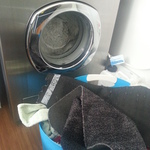 When I come in on a late shift means I can start to catch up on cleaning and tidying. Primarily washing! Cleaning and tidying is an everyday chore for Veterinary Nurses, whether it’s cleaning kennels ready for the next inpatient, to wiping down an excited dog’s slobbers that has somehow got half way up the wall!
When I come in on a late shift means I can start to catch up on cleaning and tidying. Primarily washing! Cleaning and tidying is an everyday chore for Veterinary Nurses, whether it’s cleaning kennels ready for the next inpatient, to wiping down an excited dog’s slobbers that has somehow got half way up the wall!
Once operations for the day are finished all the instruments used need to be cleaned and sterilized before being used again which can be quite a lengthy process. They firstly get cleaned with a high level disinfectant, they are then placed in our ultrasonic cleaner, this involves high frequency bubbles that remove any stuck on material. Lastly, they are placed into our Autoclave, this uses high pressure and temperatures (about 121°C!) to finally fully sterilise the instruments.
In the afternoon Richard had a little Guinea pig called Jasper who came in for a re-check. This little man has on going dental problems and is struggling to return to his normal lively self. Jasper was admitted for us to have a closer look at his mouth and teeth to see if we could figure out why. As animals do not understand why we want to examine their mouths, most need a full anaesthetic for a dental procedure. For Rabbits and guinea pigs this involves a gas anaesthetic called sevoflurane. This gas is inhaled and keeps them asleep for the whole procedure. Once we were able to examine Jasper’s mouth more fully, Richard found that there were small spurs rubbing into Jasper’s cheeks causing ulcers. For most rodents, their teeth continually grow and with the right diet, these are worn down by fibrous material such as hay and grass. If their diets aren’t correct or other problems occur such as illness or genetic malformations these teeth can overgrow and cause problems.
Jasper recovered well from his anaesthetic, trying to tuck into some freshly picked grass as soon as he woke up! Both Guinea pigs and Rabbits have very sensitive digestive systems and it’s really important to keep food going in. Because of Jasper’s reduced appetite we thought it best to syringe feed Jasper with some high energy, easily digestible food. This helps to keep his guts moving and give him enough energy to speed up the recovery process. Jasper is a wonderful, friendly Guinea pig who loves the food we syringed him, he even tried to take the syringe off me while I was feeding him! After lots of food and some well-deserved TLC, I sent Jasper back home with his owner, who was very pleased to see him.
Last but not least, a member of the public called to say they had found some very small ducklings with no mother around. After monitoring them for a while she decided to bring them in for us to check them over as no mother duck could be found. These little guys were still very young with no feathers and just soft, fluffy down. She decided to take them home to look after and feed until they are old enough.
7pm, time to go home, put my feet up and eat some tea!
Thursday
Today was mostly a day full of consults. Veterinary Nurses can perform a wide variety of clinics, including nail trims, empty anal glands, weight clinics, mobility clinics, puppy/kitten clinics, post operation checks, admits and discharges to name but a few! Most of my consults today were 2nd vaccines and today I saw a very handsome Cocker Spaniel called Rory. I gave him a little check over making sure there were no changes since we last saw him, listening to his heart, looking in his eyes, ears and mouth and double checking there were no problems at home. Rory was in full health with no concerns. Veterinary vaccinations are given by an injection under the skin in the scruff of the neck, sometimes the shock of the needle can surprise some animals and they may give a little squeak, but Rory was very brave and didn’t notice at all. He then proceeded to give me his paw and because he was such a brave man he got some treats and lots of fuss.
Vaccinations are very important in preventing your pets from catching some fatal diseases. For dogs we vaccinate them against Distemper, Hepatitis, Parvovirus and Leptospirosis. In addition, dogs can receive an elective vaccine for kennel cough; this vaccinates against Bordatella Bronchiseptica bacteria and parainfluenza virus. For cats we vaccinate against Panleukopenia virus (FPV), herpes virus, Calicivirus and Leukaemia virus (FeLV), we also vaccinate rabbits against Myxomatosis and Viral Haemorrhagic Disease (VHD). By giving yearly vaccines to your pets, we can help protect them against all these diseases and keep them happy and healthy.
Final patient of the day was Poppy, a little West Highland Terrier that had came to see Charli in the evening as she wasn’t herself, lethargic, not eating her food and vomiting. Charli admitted Poppy into the hospital for investigations to try and figure out why she was feeling so ill. This involved an ultrasound of her abdomen, an ultrasound uses high frequency sound waves which move through the body, these are then re-bounded by organs and other substances, the ultrasound reads these waves and produces a picture of the inside of the patient’s body. Soon enough Charli found the problem; Poppy had a pyometra (infection of the womb). If left untreated it can be fatal for the animal and is an illness of entire female animals. As Poppy had been so ill, Charli thought it best that we stabilise her first, giving her intra-venous fluids, anti-sickness medication and antibiotics, all of these will help her to feel more comfortable overnight, with the plan of surgery tomorrow. Poppy was handed over to Leonie, who is the night nurses this week to give her some TLC and carry on with her medications overnight.
Friday
Coming in a late means that consultations and operations are well underway, with Helen and Cat in theatre, I checked on our inpatients, making sure that they had all their medication. Poppy is looking much better today and the plan was to still go ahead with the surgery.
 Once I had checked on the in-patients, Helen and I then started operating. Our patient of the day was Rascal, a gorgeous ginger male cat. His owners had noticed that his breath was a bit smelly and when he came in for a check-up we noticed he had some tartar on his molars and a dental was recommended. During a dental patients have a full anaesthetic to ensure they are fully asleep so we can examine inside their mouths and teeth. My role in Rascal’s anaesthetic was to monitor him closely during the anaesthetic, recording his heart rate, respiratory rate and his depth of anaesthesia. For this procedure Rascal was first given a sedation which helped him relax and snooze. Once he was nice and sleepy, a tube was placed down Rascal’s trachea, inhalation anaesthetic and oxygen is then connected to the tube to keep him asleep during the procedure.
Once I had checked on the in-patients, Helen and I then started operating. Our patient of the day was Rascal, a gorgeous ginger male cat. His owners had noticed that his breath was a bit smelly and when he came in for a check-up we noticed he had some tartar on his molars and a dental was recommended. During a dental patients have a full anaesthetic to ensure they are fully asleep so we can examine inside their mouths and teeth. My role in Rascal’s anaesthetic was to monitor him closely during the anaesthetic, recording his heart rate, respiratory rate and his depth of anaesthesia. For this procedure Rascal was first given a sedation which helped him relax and snooze. Once he was nice and sleepy, a tube was placed down Rascal’s trachea, inhalation anaesthetic and oxygen is then connected to the tube to keep him asleep during the procedure.
Once the procedure was finished and the tube removed, Rascal was placed into our incubator for his recovery. It is really important to keep animals warm during any type of anaesthetic as their body cannot fully control their temperature when asleep. Popping our patients in the incubator or under lots of snuggly blankets helps to prevent hypothermia and means they wake up and go home much quicker. Recovery from an anaesthetic can take a couple hours, so we keep your pets closely monitored until they are much more awake a ready to go home.
Once Rascal was settled in the incubator and waking up, I then went to help Charli and Katie prepare Poppy for her operation. Charli was going to remove all the infected area, which included her ovaries and uterus, this means that Poppy would also be neutered, eliminating the risk of the illness reoccurring. When operating on animals, the surgical site must be made sterile, this includes shaving off any fur around the area and scrubbing the skin with a high strength antimicrobial solution, ensuring the skin is free from any bacteria, viruses, yeasts and some fungi.
I re-joined the surgical team as Charli was finishing the operation and Poppy was ready to wake up. Poppy had remained on her fluids all through the operation to help support her body systems. Poppy woke up nice and quickly from her anaesthetic, but was understandably a little cold. For our larger dogs who are too big to fit in our incubator, we have a bear hugger; this device produces warm air which inflates what is essentially an air bed with small holes in it. We wrap this around the patient to help keep them warm up. Once Poppy was feeling ready to walk around we placed her back in her kennel with a lovely soft blanket to snuggle up in.
 Because Poppy had been ill before being admitted, it was essential to get her feeling better and if she could, eat a small amount of food with us. In no time Poppy was ready to go outside for a little walk to see if she needed to urinate and once she was back, I offered her some tasty bland food. At first she wasn’t too keen, but once she had a little sniff and a lick, happily ate nearly a quarter of a tin! Charli was pleased that Poppy was making great progress and was happy to send her home today.
Because Poppy had been ill before being admitted, it was essential to get her feeling better and if she could, eat a small amount of food with us. In no time Poppy was ready to go outside for a little walk to see if she needed to urinate and once she was back, I offered her some tasty bland food. At first she wasn’t too keen, but once she had a little sniff and a lick, happily ate nearly a quarter of a tin! Charli was pleased that Poppy was making great progress and was happy to send her home today.
Katie’s Blog
Tuesday
May Day bank holiday has been and gone and after a weekend you never know what to expect, especially after a bank holiday weekend. This morning I started my shift at 8am. I was greeted by both Louise and Cat who had worked the weekend. The first job of the day is getting a detailed handover of all the patients in hospital. We had four inpatients, one of which was Pumba who was brought in by his owners over the weekend with swollen, painful eyes. Pumba was very wriggly for his eye drops so Louise had decided to keep him in to provide pain relief, regularly bath his eyes, and apply eye drops.
After the handover I had a few appointments. One was Bailey a 1 year old Labrador who was coming in for the day to be castrated. He was very nervous at first but after plenty of fuss he settled in.
After my morning consults I was down to monitor Bailey’s anaesthetic whilst Helen castrated him. This involved helping Helen induce anaesthesia, and monitoring him closely. Bailey was clipped and prepped outside theatre to keep theatre as sterile as possible. As Bailey weighs approximately 30kg Richard helped us move him into theatre and, after connecting all the monitoring equipment and manually checking I was happy he was not too deep or too light, I was happy for Helen to start. Bailey had a smooth anaesthetic and recovery. I placed Bailey back in his kennel with blankets to make him comfortable and in the blink of an eye he was happily snoozing. As a Veterinary Nurse there is a lot of cleaning involved so next I started cleaning the theatre and prep areas.
In the afternoon I had a few consultations; firstly I saw Flick, a cuddly Border collie in for his second Leptospirosis vaccination, followed by a post operative check on a lovely boy called Kaiser who was castrated the week before. I then saw Woody for a post operative check following a routine dental procedure where we discussed dental hygiene. He went home with some special Dental food to help prevent any other dental problems.
Last but not least and one of my favourite parts of the day; reuniting patients with their owners! First I discharged Pumba, making sure the owners were happy with all the different medications and happy nursing him at home. Secondly I discharged Bailey who had been a lovely day patient, after going through the post operative care with Bailey’s owner, they were reunited.
After afternoon consults I gave Leonie, that week’s night nurse a detailed handover of the nursing requirements of the inpatients and took part in clinical rounds.
Wednesday
This morning I started my shift at 8am. The first job of the day was to get a handover from Leonie who had been on nights. Afterwards I helped Richard with the daily order which includes medications for inpatients, labelling of prescription foods for clients to collect and putting away the daily order of consumables for the practice.
After this my morning consults started to arrive. First was Ollie a 9 year old adorable Boxer who was lame and was being admitted for X-rays. Ollie quickly settled and by this point my next appointment had arrived; it was Katie who is a diabetic Border collie. Katie was admitted for blood tests so we could measure her glucose levels during the day, she is always very well behaved and I took her first blood sample.
After my morning appointments I helped Richard take Ollie’s x-rays. Firstly we placed a cannula into his front leg; this allows us to administer sedative drugs straight into his vein. Whilst Ollie was sedated and relaxed Richard was able to properly examine Ollie’s painful stifle and took three x-rays at 3 different angles. As for animals under general anaesthetic, it is equally important that animals who are being sedated are being monitored very closely and this was my role. Ollie had a quick recovery. Before I knew it, it was 12 noon and a few of our inpatients were due medications, they also needed walking outside.
Next Charli needed my help holding a cat called Jez for cystocentesis. Jez is a nervous but lovely cat who has been getting recurrent cystitis, so using the ultrasound machine and a small needle we managed to take a sterile urine sample straight from his bladder. Jez was a very good boy. While Charli was speaking to Jez’s owners and arranging a discharge I made him comfortable in our cattery until his owner came to collect him. The urine was being sent to an external laboratory therefore I packaged the urine ready to be collected that evening. We use the external laboratory a lot as they have a lot more laboratory equipment than we have in-house.
Following this there was a request for a home visit, Charli and I got the visit bag ready and went on the visit. About an hour later we arrived back at the practice and I started my afternoon consults; first were Cookie and Feisty who were in for their nails to be clipped, they were both very well behaved. Next was Rufus who was a lovely Labrador in for his second vaccination and lastly Maddie was in for her anal glands to be expressed although this required an extra set of hands as she was not keen on getting them done!
After I finished my morning consults I covered reception whilst Maddy, one of our receptionist’s, went for some lunch. I enjoy working on reception from time to time as you tend to see more clients coming in to collect medications, food etc. Very shortly after Maddy returned, Charli needed my help to take a sample from Maisie a very lively Cocker Spaniel. Maisie was very well behaved. A Veterinary Nurse we often help the vets in a number of tasks.
Thursday
Today I started at 11am. The first thing I did was check on the inpatients and what day patients we had in today, making sure they were not due any more medications and they were comfortable.
When I am asked what I do as a job and I reply that I am a veterinary nurse, the most common response is ‘how nice, you get to play with puppies all day!’ Often this is not the case; however Thursday morning I was down to see two! My first appointment was a very cute 4 month old Jack Russell for a puppy club, and his adopted sister Dolly who came along for the ride. I gave them general advice on training and answered any questions they had. Puppy clubs give us a chance to make sure they are healthy, and to help answer any concerns the owners may have, which can range from nutrition to behaviour and training.
 After giving Murphy plenty of puppy cuddles I was down to monitor the anaesthetic while Helen spayed Lola a lively 3 year old Boxer. Lola had a heart murmur, which I needed to be aware of while monitoring the anaesthetic. As with all anaesthetics I kept a close eye on all her vital signs. After surgery Lola recovered very well and I placed her back in her kennel. Just before lunch time I helped Charli with a few of our inpatients including holding one of the dogs for an ultrasound of her abdomen and lunchtime checks on the other inpatients.
After giving Murphy plenty of puppy cuddles I was down to monitor the anaesthetic while Helen spayed Lola a lively 3 year old Boxer. Lola had a heart murmur, which I needed to be aware of while monitoring the anaesthetic. As with all anaesthetics I kept a close eye on all her vital signs. After surgery Lola recovered very well and I placed her back in her kennel. Just before lunch time I helped Charli with a few of our inpatients including holding one of the dogs for an ultrasound of her abdomen and lunchtime checks on the other inpatients.
After lunch my afternoon consults arrived including my second puppy of the day, Minnie a toy poodle. After lots of puppy cuddles an important part of puppy clubs is carrying out a clinical examination which includes checking their eyes, ears and making sure their adult teeth are coming though nicely. We carry out these checks to mainly check the puppy is healthy but to also get the puppy used to being examined i.e looking at their ears and mouths. I also saw a very bouncy whippet called Tara who was in for her second vaccination, I saw Tara a few weeks ago as she was spayed. With Tara came her sister Tasmin and Todd who just wanted cuddles, cuddles and more cuddles.
After my afternoon consults I started cleaning; this includes cleaning down all of the walls and floors in theatre, prep and the diagnostic suite. We also have to clean, package and autoclave the surgical kits that have been used. There is always cleaning to be done in a Veterinary practice.
Friday
I started at 10am today. I started my shift by firstly checking on the inpatients and taking them out. I also checked on the day patients; On Friday we had Nibbles in, a very cute but fast Netherland dwarf rabbit in for castration. Unlike a dog or cat who are starved before a general anaesthetic rabbits don’t need to be starved as they can’t regurgitate their food.
Firstly, Louise placed a cannula in Nibbles ear so she could safely deliver the pre-medications; pre-medications were given along with pain relief and pro-kinetic which helps to increase stomach contractions (it is very important rabbits eat straight after a general anaesthetic as there gut needs to be moving at all times).
After Nibbles was anaesthetised and prepped he was transferred to theatre where Helen castrated him. A rabbit’s heart beat should be between 200-280 beats per minute, therefore I had to listen very carefully for the individual beats when counting and had to count very fast. After Helen had finished and Nibbles was lifting his own head up he was placed in our incubator to help keep him warm. All animals, especially rabbits, are prone to hypothermia after a general anaesthetic which is due to some of the drugs we use. I provided Nibbles with some fresh grass straight away and kept a very close eye on him.
After I was happy with Nibbles recovery I bathed one of our inpatients suffering from diarrhoea; this is very important for both hygiene and clinical care.
Another day patient we had in on Friday was Newman, a very handsome cat who didn’t stop purring with us. Newman was in to have his blood pressure monitored. When measuring blood pressure we like them as calm as possible to get an accurate reading, this was no trouble in Newman as he loved cuddles and had all of his own bedding with him to snuggle in to. The blood pressure is taken using the same machine as in humans; the only difference is the cuffs are very small. We used Newman’s tail for the readings, he was very good for it, and all the measurements were recorded ready for Louise to interpret them. At this point, Nibbles was also back in his kennel hopping around happily.
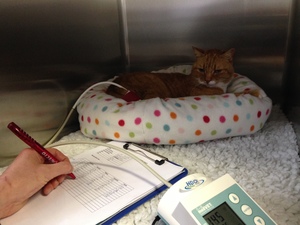 After taking a few readings from Newman I made a start on cleaning the theatre and the prep area before my afternoon consults. During the afternoon I saw Jess and Ruby, two Labrador’s who are mother and daughter; they were in for second vaccinations and Louise had a listen to Jess’s heart as she has a heart murmur. I also saw Ben, Ben was in last week for a dental and he was in today for his 2nd vaccination and to check his mouth was comfortable. His mouth looked great and he’s had no problems since the dental. Lastly I saw Lola a happy schnauzer to have her anal glands squeezed and to collect a wormer.
After taking a few readings from Newman I made a start on cleaning the theatre and the prep area before my afternoon consults. During the afternoon I saw Jess and Ruby, two Labrador’s who are mother and daughter; they were in for second vaccinations and Louise had a listen to Jess’s heart as she has a heart murmur. I also saw Ben, Ben was in last week for a dental and he was in today for his 2nd vaccination and to check his mouth was comfortable. His mouth looked great and he’s had no problems since the dental. Lastly I saw Lola a happy schnauzer to have her anal glands squeezed and to collect a wormer.
Cat’s Blog
Monday
You never really know what cases you will get from one day to the next, most are pre-booked operations and appointments but some are emergency or urgent procedures.
Today I was mainly caring for the patients in our three wards; kennels, cattery and isolation. At the start of my shift I checked who was in each ward and what they were in for. None of them were inpatients, all were just in for the day for operations and procedures. Once I had checked if any of them needed medicating or pre-operative examinations I helped Leonie, Helen and Charli with the day’s operations.
Leonie and Helen had already started spaying a cat and Charli asked me to monitor the anaesthetic for Fudge’s castration. Fudge is a gorgeous cat but he was a little bit nervous, as I have a soft spot for cats I gave him a fuss and a stroke before we gave him his anaesthetic drugs and he was soon having a little purr. It is obviously very important to have someone who has sole responsibility for monitoring the patients under anaesthesia and veterinary nurses undergo a lot of training on what to check when a patient is anaesthetised. As we are a hospital we also have a lot of monitoring equipment which I connected up to Fudge, but it is all pointless without a trained eye to make sense of all the various readings. The operation itself doesn’t take long and Charli was soon telling me she had finished and it was safe to wake Fudge up.
Once Fudge was back on his feet and safely in his bed I helped Leonie, Helen and Charli with our next patient, Louie. Louie has been having some persistent urine infections and we wanted to investigate what had been causing them. Louie is a very large, but incredibly well behaved Dogue de Bordeaux. I am so glad he is such a good boy as he is bigger than me and I wouldn’t get far if he disagreed with me! We placed a catheter into his urethra and took several samples of urine and tissue from his bladder with the aid of an ultrasound scanner. We quite often have to sedate dogs to do this sort of procedure but Louie just had a snooze all by himself!
There is always plenty of cleaning and tidying to do as a veterinary nurse, we have very strict cleaning and disinfection protocols that need to be followed, from cleaning down the walls in the theatres to sterilising the surgical instruments, so once all the operations were done I got cracking with this.
During the afternoon I had several appointments as well as making sure all the day patients were recovering well from their operations. Mimi, who had been spayed, needed water and a litter tray once she was up and about, as did Fudge. Then I got started on my evening appointments.
Alfie the Cavalier King Charles was very excited to see me initially, but it soon became evident that I would be emptying his anal glands and so he was also quite keen to leave afterwards. Helen helped me with Barney, a super wriggly Labrador with ticklish feet, for a nail trim. Lastly I saw Mossie, a lovely little pug who came to have his weight checked. He has been on a diet and is doing very well with his weight loss and it’s great to see it benefiting his health in lots of different ways.
Tuesday
Before I began my clinical nursing tasks I had a few phone calls and bits of paperwork to complete. One of my jobs is to send off insurance claim forms and liaise with insurance companies regarding claims. This was never something I had really thought about before I began working as a veterinary nurse but it soon became one of my responsibilities and I have done it for several years now. Whilst I enjoy hands on patient care much more than office work, it has taught me a lot about what different medications and procedures are used for varying medical conditions and this helped me a lot when I was studying for my veterinary nursing qualification.
I then went to see Algie, a really fluffy ginger cat. He is getting a bit older now and struggles to keep his coat well groomed. As a result, every six months or so, he comes in to be shaved. Some cats hate having this done and need to be sedated by one of the vets, Algie is very tolerant though and allowed Charli and I to brush and shave out all his matts and knots. He looked like a bit of a patchwork cat when we had finished but he was a lot more comfy.
During my ward rounds I made sure everyone was medicated, taken out to the toilet and given food and water as needed. Lucy had had an operation to remove a lump from her bottom, she was recovering very well and happy to be taken out for a walk around. We check that all the patients that have had operations are bright and happy and that they haven’t got any pain, bleeding or swelling from their various wounds.
The usual daily cleaning followed, making sure that the prep and theatre rooms were spotlessly clean ready for the next set of operations and that all the kits were ready for the autoclave.

After clinical rounds I had a few appointments, Spud had been in a week ago for a caesarean section and we delivered three healthy cocker spaniel puppies. She was in to have her wound examined to ensure it was healing, she had healed fantastically well and her mum said she was being a brilliant mum to the puppies. Teddy, a Belgian Shepherd, was castrated five days ago and he also needed the all clear for his wound. He had been a very good patient, rested well and not licked at his wound. Lastly I saw Inka, a cheeky little Jack Russell Terrier, for a nail trim. I saw Inka a lot when she was a puppy and she had a broken jaw. She is very good when she comes in and it’s lovely to see her doing so well now that she is grown up!
Wednesday
I didn’t start my shift until 10am today and so there was already quite a lot going on by the time I got to work. Charli and Leonie were castrating Kaiser and Woody and would then be performing a dental procedure on Oliver. Richard and Kat would be spaying Beau and Katie was in to have her blood glucose levels checked throughout the day.
I checked all of the dogs who hadn’t gone through to theatre yet and measured their heart rate, breathing rate and assessed their hydration. All the nurses perform these pre-op checks on all the patients, it is useful to have a parameter to measure against when they are recovering and we can make sure there are no problems before we begin. Everyone was very well behaved for their examinations.
Katie is a diabetic dog and her owners are just starting to give her twice daily insulin injections. As it is so important she gets the right amount of insulin to control her blood sugar levels, I am helping them to start off the injections and make sure she gets exactly what she needs. Katie is such a lovely dog and so well behaved for her injections, it certainly makes it easier to teach her mum how to inject her as she sits so still! Today we were measuring how well the insulin injections were controlling her blood sugar levels. Katie had a small blood sample taken from her front leg every two hours and I mapped the results on a chart for Richard to interpret.
During my morning appointments I saw Alfie and Tilly, a dog and cat from the same family. Alfie has been putting on too much weight and Tilly had been losing it! Tilly was having a few problems with stress at home, but her mum and dad took advice off Louise and she is now much happier and has put the right amount of weight on to be nice and slim but not too skinny. Alfie on the other hand is a bit too porky! We discussed all the food he gets during the day, including training treats, what exercise he does and when and who feeds him. We then came up with a plan to reduce his calorie intake but still make sure he is a happy boy and not feeling left out. I’ll be seeing him back in a few weeks to monitor his progress.
As the operations finished one by one I got my kennels full of patients again. When they are recovering from surgery we again check their heart and breathing rates, temperatures and how happy they are as well as taking them to the toilet and offering food and water as needed. All of them were good as gold and were very chilled out in their kennels, this is always what we aim for and makes for a lovely working environment as you know they are comfy and relaxed.
My last appointment of the day was Cleo. She had been spayed and had a mass removed from one of her mammary glands by Richard five days previously and she had come for her routine post op check. Cleo had been doing really well at home and hadn’t been licking or scratching at her wound. As she had two surgeries in one she had two wounds to examine. The smaller spay wound had healed beautifully and was barely noticeable. The larger wound, where the mass had been removed, had got a few skin stitches to help with any tension the wound may be put under and was also healing well. We tend to leave skin stitches for at least ten days and so I booked Cleo in for next week. I left her mum and dad under the strict instructions that she must continue to rest and wear her buster collar so she didn’t start to lick the wounds as they healed further. They were more than happy with this, even if Cleo wasn’t!
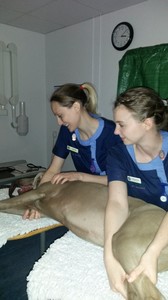 My final task was to help Hannah our visiting cardiologist and Kat perform an ultrasound scan on Luna, a totally loony Weimaraner. Luna has a heart condition and we would be monitoring how well her medication was controlling her condition. Firstly, while Luna was relatively calm, we measured her blood pressure. Hannah placed a small cuff around her tail, this occludes the blood flow and a machine measures the vibrations made by blood flowing back through the vessels as the pressure in the cuff is released. Kat and I were charged with keeping Luna calm to try and get an accurate resting blood pressure measurement. We then placed Luna onto the scanning table and Hannah used the ultrasound machine to view and measure her heart and its various functions. Thankfully Hannah was very quick as Luna loses patience rapidly, but is always very waggy! We finished off by taking a blood sample to check that none of her medications were causing any problems elsewhere in her body. I love having our visiting specialists come as we get to learn new things and see lots of different cases that we might otherwise have to refer over to other hospitals.
My final task was to help Hannah our visiting cardiologist and Kat perform an ultrasound scan on Luna, a totally loony Weimaraner. Luna has a heart condition and we would be monitoring how well her medication was controlling her condition. Firstly, while Luna was relatively calm, we measured her blood pressure. Hannah placed a small cuff around her tail, this occludes the blood flow and a machine measures the vibrations made by blood flowing back through the vessels as the pressure in the cuff is released. Kat and I were charged with keeping Luna calm to try and get an accurate resting blood pressure measurement. We then placed Luna onto the scanning table and Hannah used the ultrasound machine to view and measure her heart and its various functions. Thankfully Hannah was very quick as Luna loses patience rapidly, but is always very waggy! We finished off by taking a blood sample to check that none of her medications were causing any problems elsewhere in her body. I love having our visiting specialists come as we get to learn new things and see lots of different cases that we might otherwise have to refer over to other hospitals.
Thursday
I spent most of my day today looking after Daisy a very special little dog. When she was a puppy she was involved in an accident which resulted in her having one of her front legs amputated. She manages amazingly well on three legs but obviously we have to make sure she doesn’t injure any of the remaining ones! Sadly Daisy became very lame on her back leg a couple of weeks ago and after examining her Richard diagnosed her with a Cruciate ligament rupture. This meant Daisy needed surgery and she had that with Helen and I today.
Helen had already given Daisy her pain relief and sedation pre-med before I came in and so by 11am she was ready for surgery. We placed an intravenous catheter in her one front leg and placed her on a drip. As Daisy is so well behaved we then started to shave her fur while she was still awake. This meant she would have a shorter anaesthetic which is better for many reasons including keeping her warmer. Helen prepared lots of other bits of medication such as antibiotics, strong pain relief and local anaesthetic. We like to use ‘Multi modal analgesia’ which basically means lots of different types of pain relief given before, during and after surgery to keep our patients as comfy as possibly. Helen then induced Daisy’s anaesthetic and I monitored her heart and breathing rates, depth of anaesthesia and let Helen know if I felt she was in any pain or if I had any concerns. Daisy was a star patient and did all the right things while she was asleep. The surgery took about an hour in which time Helen looked into her knee joint and assessed it, placed a prosthetic cruciate ligament, instilled some local anaesthetic and sewed everything back up.
When she was waking up we placed Daisy into our incubator to make sure she was toasty and warm. She woke up really well and I iced her leg to help reduce any swelling. We do this for all limb surgeries but as Daisy doesn’t have many to spare it is even more important that she heals quickly and less inflammation will help with this.
I kept a close eye on Daisy during the day and continued to monitor her and asses her for pain. Daisy will need a period of rest but will be back on her feet in no time as she still managed to balance on two legs very well before we operated!
Aside from caring for Daisy I had a few meetings and other administration tasks today. Not something all nurses enjoy but it is really nice to be involved in practice decisions and be able to help implement changes where they are needed.
Friday
It was dental day for Helen and I today. After doing a few morning appointments including weighing one of my weight club cats and emptying some Bulldog anal glands I admitted Ben the Hungarian Vizsla for his dental procedure. Firstly I weighed Ben and then I went through the consent form with his mum. All of the medications we give are dosed according to weight so an accurate weigh in on the day is very important. I explained that Ben would need an anaesthetic and we would assess each of his teeth as we cleaned them up to see if any damaged or rotten ones needed removing. Ben is also on pain relief for his elbow arthritis so I made sure to ask when he last received his medication so that we didn’t give him a double dose. Once we were happy with all the details on the consent form Ben’s mum signed to give us permission for the dental procedure. I see Ben outside of work and so he was a bit confused about why I was staying with him but he came through to kennels happily.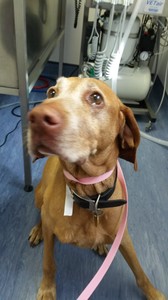
Ben came through to kennels and decided to start barking! Luckily Richard had his pre-med ready to go and within five minutes he was much quieter and snoozing away.
We need to give the pain relief and the pre-med time to work so about 45minutes after he was injected we took Ben through to the dental room and started his procedure. Ben had an intravenous catheter placed and given injectable anaesthesia induction, we then placed a breathing (endotracheal) tube into Ben’s trachea and connected him up to the monitors, oxygen and inhalation anaesthetic agent to keep him asleep. I closely monitored Ben while Helen descaled and assessed his teeth. Ben had one tooth removed and the rest were just cleaned up, he has big teeth so this can actually take quite a while to get them shiny again!
When Ben had woken up Helen rang his mum and explained what we had done and organised a time for him to go home, we like all the patients to stay in for a few hours to be monitored and Ben was settled in his kennel after his morning vocals.
Helen and I then had the same procedure to perform on Woody a Cavalier King Charles Spaniel, sadly Woody is a bit older and needed a few more teeth our but he will feel much happier without them.
Daisy is still in today and will be keeping me company over the weekend. She is doing well and her leg isn’t very painful. We often send four legged doggies that have had the same surgery home the next day but as we need to take extra care of this leg Richard and her mum and dad decided rest with us would be for the best.


